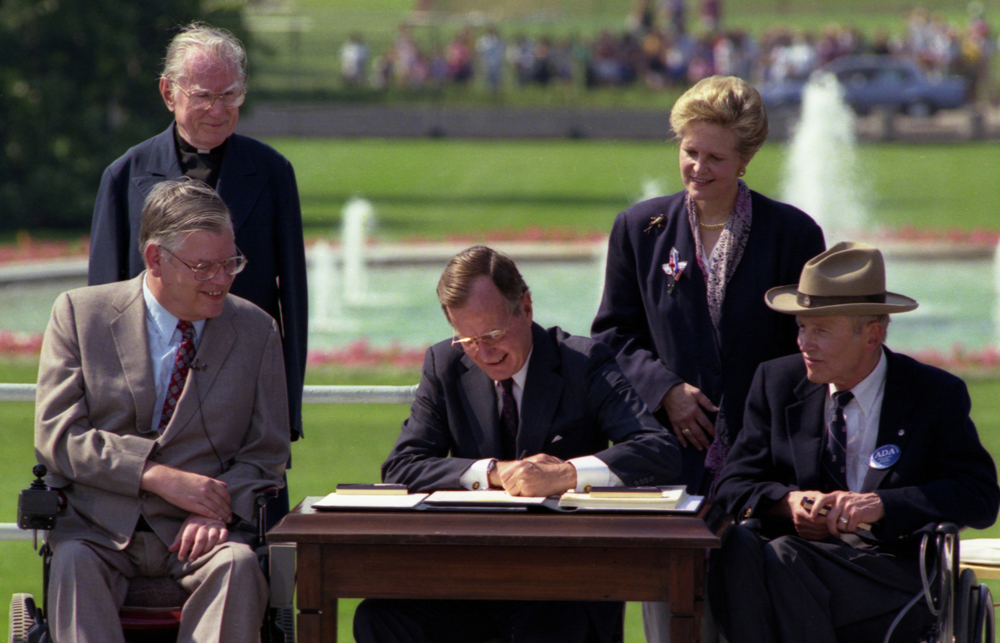
Federal Civil Rights Laws
Important federal civil rights laws affecting people with disabilities:
- 1964 Civil Rights Act: prohibits discrimination on the basis of race, religion, ethnicity, national origin, and creed — later, gender was added as a protected class.
- 1970 Urban Mass Transit Act: requires that all new mass transit vehicles be equipped with wheelchair lifts. As mentioned earlier, it was twenty years, primarily because of machinations of the American Public Transit Association (APTA), before the part of the law requiring wheelchair lifts was implemented.
- 1973 Rehabilitation Act: particularly Title V, Sections 501, 503, and 504, prohibits discrimination in federal programs and services and all other programs or services receiving federal funding. As Congress was convinced that society’s barriers and prejudices hindered the civil rights of the disabled, legislation could not be interpreted in such a way to indicate it was the disabled person’s responsibility to find accommodation. (full text below)
- 1975 Developmental Disabilities Bill of Rights Act: among other things, establishes Protection and Advocacy (P & A).
- 1975 Education of All Handicapped Children Act (PL 94-142): requires free, appropriate public education in the least restrictive environment possible for children with disabilities. This law is now called the Individuals with Disabilities Education Act (IDEA).
- 1978 Amendments to the Rehabilitation Act: provides for consumer-controlled centers for independent living.
- 1983 Amendments to the Rehabilitation Act: provides for the Client Assistance Program (CAP), an advocacy program for consumers of rehabilitation and independent living services.
- 1985 Mental Illness Bill of Rights Act: requires protection and advocacy services (P & A) for people with mental illness.
- 1988 Civil Rights Restoration Act: counteracts bad case law by clarifying Congress’ original intention that under the Rehabilitation Act, discrimination in ANY program or service that is a part of an entity receiving federal funding — not just the part which actually and directly receives the funding — is illegal.
- 1988 Air Carrier Access Act: prohibits discrimination on the basis of disability in air travel and provides for equal access to air transportation services.
- 1988 Fair Housing Amendments Act: prohibits discrimination in housing against people with disabilities and families with children. Also provides for architectural accessibility of certain new housing units, renovation of existing units, and accessi bility modifications at the renter’s expense.
- 1990 Americans with Disabilities Act: provides comprehensive civil rights protection for people with disabilities; closely modeled after the Civil Rights Act and the Section 504 of Title V of the Rehabilitation Act and its regulations. The modern history of civil rights for people with disabilities is three decades old. An essential piece of this decades-long process is the story of how the Rehabilitation Act of 1973 was finally passed and then implemented. It is the story of the first organized disability rights protest.
The Rehabilitation Act of 1973
In 1972, Congress passed a rehabilitation bill that independent living activists cheered. President Richard Nixon’s veto prevented this bill from becoming law. During the era of political activity at the end of the Vietnam War, Nixon’s veto was not taken lying down by disability activists who launched fierce protests across the country. In New York City, early leader for disability, fights, Judy Heumann, staged a sit-in on Madison Avenue with eighty other activists.
Traffic was stopped. After a flood of angry letters and protests, in September 1973, Congress overrode Nixon’s veto and the Rehabilitation Act of 1973 finally became law. Passage of this pivotal law was the beginning of the ongoing fight for implementation and revision of the law according to the vision of independent living advocates and disability rights activists. Key language in the Rehabilitation Act, found in Section 504 of Title V, states that:
No otherwise qualified handicapped individual in the United States shall, solely by reason of his handicap, be excluded from the participation in, be denied the benefits of, or be subjected to discrimination under any program or activity receiving federal financial assistance.
Advocates realized that this new law would need regulations in order to be implemented and enforced.
- By 1977, Presidents Nixon and Ford had come and gone. Jimmy Carter had-become president and had appointed Joseph Califano his Secretary of Health, Education, and Welfare (HEW). Califano refused to issue regulations and was given an ultimatum and deadline of April 4, 1977. April 4 went by with no regulations and no word from Califano.
- On April 5, demonstrations by people with disabilities took place in ten cities across the country. By the end of the day, demonstrations in nine cities were over. In one city, San Francisco, protesters refused to disband.
Demonstrators, more than 150 people with disabilities, had taken over the federal office building and refused to leave. They stayed until May 1. Califano had issued regulations by April 28, but the protesters stayed until they had reviewed the regulations and approved of them.
July 26, 1990 – The Americans with Disabilities Act
AAPD (American Association of People with Disabilities) celebrates some of the groups and people who made the ADA possible. Check out the AAPD exhibit on Google’s Cultural Institute.

